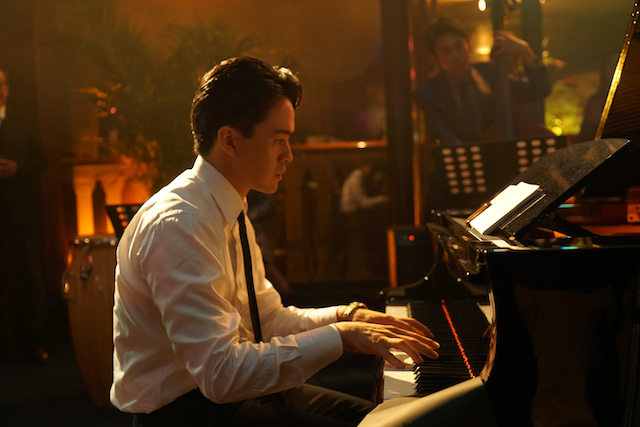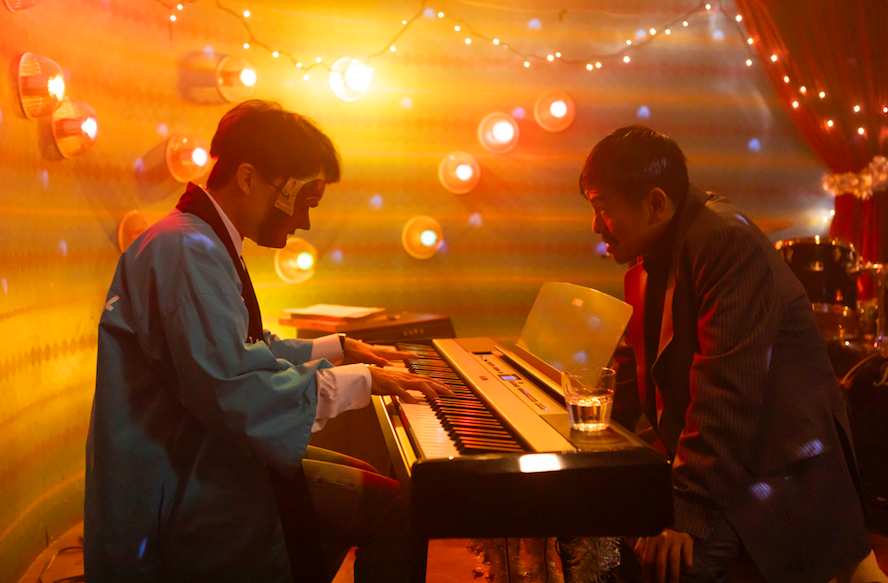
©Courtesy of Tokyo Theater Company
Japan Cuts opens its 2024 edition at Japan Society with the North American Premiere and Opening Night Film Between the White Key and the Black Key, at the presence of director Masanori Tominaga.
Between the White Key and the Black Key is an autobiographical essay by Hiroshi Minami, a leading Japanese jazz pianist, published in 2008, and thanks to this autobiographical publication Tominaga found his inspiration for an unconventional biopic.
The screenplay for the movie was jointly written by Masataka Tomioka and Tomoyoshi Takahashi, who daringly adapted Minami’s memoir into a one-night story. The real life Hiroshi Minami was born in Tokyo in 1960, where he completed his studies in Music, before receiving a scholarship at Berkeley. From the Nineties onwards, he expanded his activities to Switzerland, France, Germany, Denmark, and other countries, interacting with European musicians and touring.
The enticing aspect of the motion picture, that is inspired by the pianist’s story, is the existentialist premise from which it takes off. What would happen if our ingenue and younger self met the more jaded and adult self? This is exactly the dynamic that is examined by Masanori Tominaga in Between the White Key and the Black Key.

©Courtesy of Tokyo Theater Company
The film is set on December 28th of 1988, in Tokyo’s district of Ginza. Sosuke Ikematsu(“The Last Samurai,” “Shin Kamen Rider“) stars as what initially appear to be two different pianists. The narrative unfolds as their destinies take a dramatic turn during that one fateful night.
The younger Hiroshi is a classically trained musician with dreams of making it in the jazz world. He works in a cabaret club, although his career is not heading where he wishes. However, he keeps striving through the encouragement of his teacher, who reminds him that he needs to play more ‘nonchalant.’ In parallel to this young man who is trying to find his place in the sun, there’s Minami who seems to have established himself.
He is more disenchanted, and tells a new hire at the fancy club where he works that musicians are purely decorative, like carpets or flower vases. That’s why he’s secretly planning to move to the United States and enroll at the prestigious Berkeley College of Music in Boston. The fates of both Hiroshi and Minami (i.e. Hiroshi Minami during two different stages of his life) are brought together by a single piece: Nino Rota’s Love Theme from The Godfather. Young Hiroshi loses his cabaret job after playing the tune at the behest of a nameless, music-loving mobster who’s fresh out of jail (Go Morita).
He isn’t aware that there’s only one person in town who’s allowed to request it: local yakuza boss Kumano (Takashi Matsuo). And only one pianist is allowed to play it: Minami. This song could actually be that point of encounter between the ‘white key’ of the pure-Hiroshi and the ‘black key’ of the somber-Minami. Duality can be examined through the yin-yang depiction of a single individual, who is characterised by polarising traits, that ultimately represent two sides of the same coin. Both versions of that individual confront the pursuit of dreams and disillusionment.
Since the white keys of a piano principally represent the musical tones, while the black ones represent the sharp or flat intervals between these musical tones, the title of the film could also be understood as the place where time intersects and dimensions involuntarily collide. This hypothesis is epitomised in the last scene, that creates a bridge between life and death and establishes a mundane conversation between the two realms. The cosmos and earthly plane find a unity through the power of music, as a character points out (quoting Charlie Parker), “It’s not jazz if we can’t see the stars.”

©Courtesy of Tokyo Theater Company
The narrative mode may evoke the Möbius strip, in terms of how we experience time in a nonlinear way, as memory, events and haunting prophecies coalesce. This allows the protagonist to cross paths with his past version, his older self and his potential future representation. It somehow reminds us of Scrooge’s journey through time in A Christmas Carol, that provided him a chance of redemption. In Between the White Key and the Black Key this exploration is more subtle, also because Hiroshi Minami isn’t despicable as the Dickensian character, but rather someone we could easily identify with.
Between the White Key and the Black Key is further enlivened by engaging performances by pianist Riisa Naka, saxophonist Kei Matsumaru, Kazuya Takahashi as the club’s bandmaster, and Crystal Kay who appears as a visiting American singer. The picture is a true love letter to jazz as it includes iconic songs such as East of the Sun (and West of the Moon) written by Brooks Bowman, during the Thirties, and As Time Goes By also from that decade, that was eventually made famous with the film Casablanca.
Jazz enthusiasts will also be delighted by the inclusion of Recado Bossa Nova by Hank Mobley and Nobody Knows You When You’re Down and Out, which marked a blues standard written by pianist Jimmie Cox that was originally performed in a Vaudeville-blues style and was popularised during the Prohibition era. Equally enchanting is the very musical composition by Hiroshi Minami, Nonchalant, that represents the theme of the film and the spirit of improvisation intrinsic to jazz, that is the source of inspiration for the lead character.
Music is the greatest protagonist of the picture, since it becomes a stage where actors can confront life equally, and it often becomes a tool to comfort the soul. As a character says “What makes humans different from other animals are poetry and music.” Ultimately a good jam session becomes a stupendous metaphor for life.
Final Grade: B+
All photos are kindly provided by Japan Cuts.

